|
Advantech MARS-3100S
Embedded system semi-rugged Tablet PC
(by Conrad H. Blickenstorfer -- view PDF version)
The MARS-3100S is an industrial tablet computer made by Advantech, the experienced Taiwanese embedded and industrial computing maker that is seeking to establish itself in the US and other markets. Founded a quarter of a century ago by three ex-Hewlett Packard engineers, Advantech provides a wide variety of web-based technologies, computing platforms and customization services in the areas of embedded & industrial computing, eServices & applied computing, and industrial automation. Advantech has over 3,000 employees and maintains a growing international sales, marketing and support network. Advantech sells either directly or works with third parties to provide complete computing solutions for various industries including medical computing, vehicle mounts, panels, rugged handhelds, and industrial Tablet PCs like the MARS-3100S featured here.
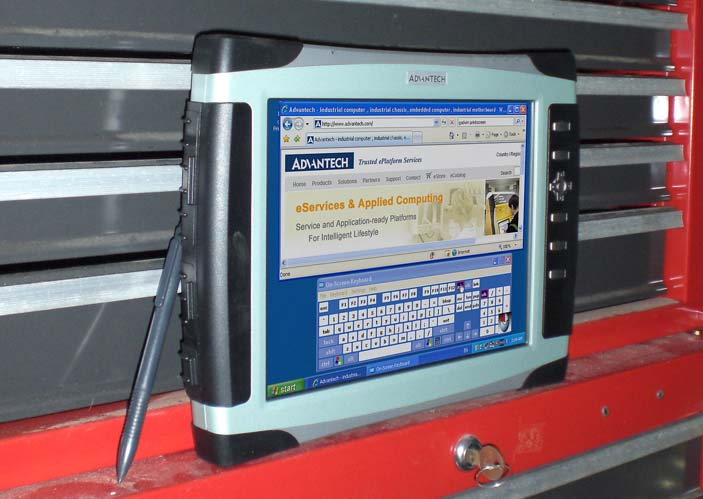
How does the MARS-3100S relate to the MARS-3100R?
If you read our very detailed analysis of Advantech's other industrial tablet computer, the MARS-3100R, you may look at the subject of this review, the MARS-3100S, and note a remarkable resemblance. In fact, they look exactly alike. For this reason I want to quickly explain the difference, which is actually considerable:
The MARS-3100R runs Windows XP Professional on a 1.2GHz Intel Core Duo processor whereas the MARS-3100S runs XP Embedded on a 500MHz AMD LX800 chip. There are other technological differences as well, but most people will look at the processor specs and conclude that the 3100R is a fast, modern machine whereas the 3100S is underpowered.
We couldn't blame them as on the surface there seems a tremendous difference between the speedy and complex Core Duo and the slower and much simpler AMD LX processor. If they ran benchmarks (and we did), the result wouldn't be pretty for the AMD LX box and the machine quickly dismissed as too slow. But that would be a grave mistake. See, Advantech didn't design the 3100S as an underpowered loss-leader so they could then guide customers to the faster Core Duo machine. They designed those two machines for very different purposes. The fact that they share the same basic design simply means Advantech started out with a rock-solid rugged platform that is equally well suited to both implementations.
Windows XP Embedded
The key to understanding the MARS-3100S and what it can offer is in understanding the difference between a general purpose operating system and an embedded operating system.
A general purpose OS, like Windows XP Professional, is just that, general purpose. You can do anything you want with it, and run anything you want on it. With that in mind, Microsoft equipped Windows XP with all the drivers and software and utilities one could possibly need. The result is a rather large operating system with numerous processes and services running all the time, all consuming memory and power.
An embedded operating system is totally different. The idea is to only use what you need to perform a certain task and leave everything else behind. This greatly reduces the size of the operating system and dramatically reduces hardware requirements. XP Embedded is generally used for smart, connected and service oriented commercial and consumer devices that do not need all of Windows XP, yet can still run thousands of existing Windows applications. An embedded OS can easily be as small as 40MB and it's even possible to cut it all down to around 8MB with a bootable kernel.
XP Embedded is not one-size-fits all. A company will determine exactly what a machine is for and what it should be able to do. They then include as many components (hence the term "componentized" operating system) as they need. There are over 10,000 available and it's easy to create lean, nimble embedded OS platforms that can still do sophisticated high level tasks like advanced multimedia, browsing, communications or whatever a task requires. An embedded OS can even run as a real-time OS via third party plug-ins. Essentially you get the power of the basic Windows XP engine, but without any overhead you don't need.
Which means that in an embedded systems machine, benchmarks do not necessarily tell the true story. They simply measure raw power, but not how efficiently that power is put to use. What all this boils down to is that the 3100S is much faster than you'd think it is based on its hardware specs. In fact, it's so quick that almost no one would believe it runs on a lowly 500MHz processor and just 512MB of RAM.
That said, let's take a look at this interesting machine.
A well balanced design
The approach Advantech's engineers and designers took with the MARS tablets is clear: create a compact, flexible, lightweight tablet computer with a large display. The MARS-3100S has about the footprint of a sheet of paper (11.8 x 8.85 inches) and is less than an inch and a half thick. It weighs just under five pounds, making it fairly easy to carry around. Despite its compact size, the MARS has a 10.4-inch display instead of using the 8.4-inch format still prevalent in this class of computers. The 3100S doesn't have the 3100R's XGA 1024 x 768 pixel XGA resolution; 800 x 600 SVGA will have to do. Still, the larger screen size makes it easier to use and read the display. The screen also has very wide horizontal viewing angle and an acceptable vertical one.
While one of the selling points of the 3100R is its powerful Core Duo processor, the 3100S makes do with much less hardware. The AMD Geode LX800 processor was really designed for embedded x86 solutions where energy-efficiency matters. Its TDP (Thermal Design Power) is just 3.6 watts at maximum speed. This does not only bode well for battery life, it also allowed a fanless design that barely warms up at all. Combined with the solid state hard disk, the 3100S is completely and totally silent -- a welcome change from the annoying fans of most mobile hardware these days.
Avantech specs indicate that the 3100S runs between 2.5 and 3.5 hours on a charge from its 40 watt-hour battery. In our tests, the machine easily bettered that mark, running up to 4.5 hours on a charge.
Power efficiency and silent running are always appreciated, but they would not be enough if the computer is slow. Much to Advantech's credit, the 3100S is not slow. I don't think I've come across a machine with a bigger discrepancy between benchmarks and perceived performance. As stated above, the benchmarks are typical for a machine with so little hardware -- low -- but the machine feels quick. Screen response, especially, is instantaneous and there is none of the sluggish screen redraw so often seen on low-power machines. Part of this is no doubt due to the solid state disk, but overall the surprising performance points to a good design job by Advantech.
Touch panel
Unlike the 3100R which has dual panel active and passive input, the 3100S uses only a resistive touch screen that can be operated either with the supplied plastic stylus or with a finger. The stylus is a full-size black plastic affair that looks like a Wacom pen, but isn't. It neatly and securely fits into a garage indent in the back of the unit where it is held in place by two rubber inserts.
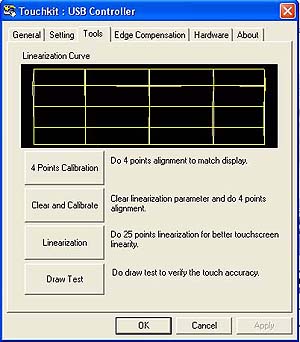 The resistive touch panel controller communicates with the processor via USB and is very fast. A special Touchkit control panel adjustment and optimization for accurate touch performance and ease of use. The panel is quite elaborate. You can set linearization either to nine or 25 points, with 25 points offering maximum accuracy. You can also set double click time and area, beeps, auto right click, cursor stabilization, and five different mouse modes (like click on touch, click on release and so on) according to personal preference. I found it particularly nice that I could set the panel so a right mouseclick worked like with an active digitizer: tap and hold. A small mouse icon always shows whether the left or right mousebutton is currently selected. The resistive touch panel controller communicates with the processor via USB and is very fast. A special Touchkit control panel adjustment and optimization for accurate touch performance and ease of use. The panel is quite elaborate. You can set linearization either to nine or 25 points, with 25 points offering maximum accuracy. You can also set double click time and area, beeps, auto right click, cursor stabilization, and five different mouse modes (like click on touch, click on release and so on) according to personal preference. I found it particularly nice that I could set the panel so a right mouseclick worked like with an active digitizer: tap and hold. A small mouse icon always shows whether the left or right mousebutton is currently selected.
If you intend to use the computer primarily with finger touch, you can set it so that the driver stops reporting points when movement is within a pre-defined range. This way the cursor will not jitter around when the same point is touched again or when you move a pen within a small area.
The Touchkit also has elaborate edge compensation controls. With touch screens and digitizers it's often difficult to touch or select items at the edge of the panel, and especially so when the LCD display runs all the way to the kind of thick protective bezel most rugged slate have. The 3100S touch panel allows you to precisely define edge compensation for all four sides, i.e., set it so the cursor thinks the edge is either farther away or closer in. Precise configuration can make for optimal usability and responsiveness in touch applications.
Another quality of this touch screen is that it does not introduce any optical artifacts or distortions at all.
Design and construction
Except for some small details, the Advantech MARS-3100S looks identical outside to the top-of-the-line 3100R model. It is an elegant machine that combines excellent industrial design with good ergonomics. The very sturdy aluminum-alloy housing of the tablet consists of a front and a rear half that are held together and sealed by eight screws. 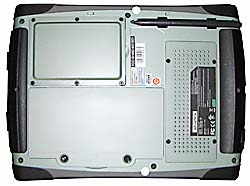 The top and bottom of the unit have a hard gray plastic cap with a rubberized surface that is completely integrated into the design. They provide extra protection and also include pushbutton controls, indicator lights and. at the bottom, the speaker. The top and bottom of the unit have a hard gray plastic cap with a rubberized surface that is completely integrated into the design. They provide extra protection and also include pushbutton controls, indicator lights and. at the bottom, the speaker.
For extra protection against bumps and falls, all four corners of the 3100S are covered with thin black rubber bumpers that are also integrated into the design instead of just screwed on top of it. They can be replaced in case they get scratched or marked. The way Advantech integrates protective elements into the design instead of tacking them on is impressive and reminiscent of modern vehicles that also integrate bumpers and protection into elegant design.
The left and right side of the housing's clamshell halves have cutouts for two ergonomic black plastic inserts. These provide protection from side impacts, and also cover all the peripheral ports. The peripheral seals/covers are all integrated into the lower part of the protective cladding on each side. The protective plugs are attached to the unit via rubber hinges and cannot get lost. They require a firm push to sit and seal nice and tight. There's only a small ridge to pry them open and there isn't much of a chance for them to accidentally open by themselves.
Rugged computer manufacturers must decide whether they want to cover and seal each port separately or have a door or cover protect several at once. The former solution makes for lots of small parts, the latter exposes all ports even when only one is used. Advantech does a bit of both, sealing some interfaces individually (power, video, serial) while combining others (RJ45, USB and audio). For extra protection, the 3100S comes with small rubber plugs for each and every jack and port. Problem is that they are separate pieces and thus easily lost. Keep them in a safe place when they are not on the computer.
 In the picture to the left you can see the left side of the computer with its hinged plastic covers and individual rubber caps on some of the ports. The picture above shows the bottom of the 3100S with the battery (bottom left of the unit) integrated into the design of the housing so that is its own cover. In order to minimize the area potentially exposed to water or dust, Advantech completely sealed the battery by placing it inside its own housing, and then sealed the area where the battery contacts are with a separate o-ring gasket. The battery is securely held in place by two large screws that can be operated by coins, a flatblade screwdriver or even your fingernails. This design potentially allows for a larger and more powerful battery at the cost of it protruding a quarter of an inch or so. I don't think Advantech currently offers such a battery. In the picture to the left you can see the left side of the computer with its hinged plastic covers and individual rubber caps on some of the ports. The picture above shows the bottom of the 3100S with the battery (bottom left of the unit) integrated into the design of the housing so that is its own cover. In order to minimize the area potentially exposed to water or dust, Advantech completely sealed the battery by placing it inside its own housing, and then sealed the area where the battery contacts are with a separate o-ring gasket. The battery is securely held in place by two large screws that can be operated by coins, a flatblade screwdriver or even your fingernails. This design potentially allows for a larger and more powerful battery at the cost of it protruding a quarter of an inch or so. I don't think Advantech currently offers such a battery.
The compartment above the battery contains the hard disk. But where the 3100R has a shock-mounted conventional hard disk, the 3100S has a floating, rubbermounted CF Card slot assembly that, in our machine accommodated a Transcend 4GB Ultra Industrial CF Card. CF Cards are inherently rugged, and one that's rubber-mounted will certainly never suffer from impact. The cleverly designed rubber mount also makes certain that the card does never dislodge from its socket. The metal cover is secured via six screws and has an o-ring gasket for watertight sealing.
The grill to the right of the battery and SSD compartment looks like it might cover a fan but that is not so. There are heat exchange ribs underneath the cover, but no entry into the inside of the unit.
Wireless and expansion
Integrated wireless communication is standard in almost all current computers, and the MARS-3100S is no different. It comes with a 802.11a/b/g mini-PCI WiFi module that can either be controlled by the standard Windows Zero Configuration utility which our review unit used, or presumably also via the substantially more comprehensive and well-documented utility from Ralink which we used in the 3100R model. RaUI is a tool for advanced users who want to have precise control over their wireless setup. The statistics section of RaUI can be used to detect network problems. A special WMM panel controls wireless multimedia. Another one handles WPC (Wi-Fi Protected Setup) configurations. (If you want to stay with the standard Microsoft setup, Ralink can still provide a variety of monitoring functions without interfering with the Windows Zero configuration or profiles.)
Bluetooth Version 2.0 with EDR (Enhanced Data Rate) is optionally available, as is GSM/GPRS/EDGE Wide Area Network radio that can be integrated in what Advantech calls the SmartBay. Our review unit did not have the Wide Area Network function that includes a SIM slot located on the right side of the unit. Whatever radio options you specify will be supported with the required internal antennas, so you do not need external ones.
Like the 3100R, the 3100S does In terms of expansion cards, the standard unit doesn't have any. That is not an unreasonable design decision for a rugged device as external card slots are notoriously difficult to seal. There is, technically, a CF Card interface inside the unit, but that takes the place of the hard disk and is used for the SSI disk on which the XP Embedded OS is installed.
Connectivity
As far as ports go, the standard Advantech MARS-3100S is fairly well equipped, especially for a unit with this high degree of sealing. The pictures shown here are from the 3100R as they are identical.
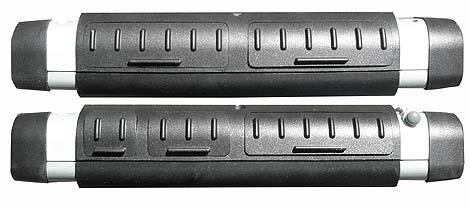 Along the left side there are three protective plugs, here shown closed. One covers the power jack; one a standard analog video-out port; and a larger one audio in and out, a USB 2.0 port and an RJ45 jack for landline LAN.
Along the left side there are three protective plugs, here shown closed. One covers the power jack; one a standard analog video-out port; and a larger one audio in and out, a USB 2.0 port and an RJ45 jack for landline LAN.
Along the right side are two protective plugs. One covers a standard DB-9 RS232 connector but the 3100R's second USB port is missing. The other covers the optionally available SIM slot that our tester did not have. Not having a second USB port is a potential disadvantage as almost every peripheral uses USB these days. A USB expansion hub may be necessary.
The top of the unit does not have any ports. Instead, that's where you find the main on/off button as well as the wireless on/off button. They are push button areas that are part of the protective upper endcap and thus inherently sealed. There are also four indicator lights. To the left one that shows whether wireless is on, and to the right a battery of three: power, hard disk activity, and battery status. The lights are built into the forward edge so that they are visible both from top and from the front.
The bottom has a docking connector with its own protective rubber seal that is attached to the unit so it cannot get lost. Next to it is a recessed area to park the docking connector plug when the unit is placed into the dock. Here's how it looks:

A number of hardware buttons are integrated into the protective cladding on the right side. There is a standard 4-way navigation diamond with a small enter button in the center. Above it are the "security" key that brings up the Windows Task Manager and a screen rotation button that quickly rotates counterclockwise in 90 degree increments. Below the navigational diamond are three user-programmable function keys. By default, F1 brings up the on-screen keyboard and F2 the very helpful Advantech Central Manager utility.
Advantech Central Manager
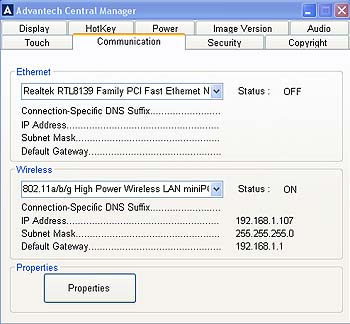 Lacking an integrated keyboard, Tablet PC slates rely on good software for optimal operation. Ideally, a user should be able to perform all configuration, maintenance, and operation tasks with the tap of a finger or pen. To help make that possible, Advantech ships the MARS-3100S with its ACM (Advantech Central Manager) application. As you can see on the right, it is a handy tabbed utility that allows instant access to all the important system and configuration areas. ACM is configured to launch by pushing one of the hardware function keys. Lacking an integrated keyboard, Tablet PC slates rely on good software for optimal operation. Ideally, a user should be able to perform all configuration, maintenance, and operation tasks with the tap of a finger or pen. To help make that possible, Advantech ships the MARS-3100S with its ACM (Advantech Central Manager) application. As you can see on the right, it is a handy tabbed utility that allows instant access to all the important system and configuration areas. ACM is configured to launch by pushing one of the hardware function keys.
The "Touch" function lets you quickly calibrate the touch screen in 4-point mode, access the above-described touch panel utility, and also configure mouse properties. "Communication" (see picture to the right) shows which interfaces are active, and what their IP address, subnet mask and gateway is. That can come in very handy for network configuration and tracking tasks. "Audio" lets you quickly set speaker and microphone levels without having to fumble with the Windows controls (I should mention that the 3100S uses Realtek AC97 audio and not HD audio like the 3100R). "Display" let you rotate, set brightness, and get quick access to the Windows Display Properties control panel. "Hotkey" allows instant programming of the hotkeys. You'll appreciate that if you encounter repetitive tasks in the field. "Power" gives a quick overview of the current battery situation and also provides one click access to the Windows Power Options Properties panel.
Utilities like the Advantech Control Manager may be just small extras, but they can make a big difference in how easy it is to configure and operate a computer. Users will appreciate Advantech having thought this through.
Operating System
When we reviewed the MARS-3100R, we wondered why Advantech chose to ship the device with Windows XP Professional and not the Tablet PC Edition. While there were all the requisite pen-specific functions and utilities I missed the significant additional functionality of the Tablet PC Edition such as electronic ink in Microsoft Journal, handwriting recognition, and numerous utilities and applications that should be part of the overall tablet experience.
Things are different on the 3100S. Since it does not have an electromagnetic digitizer, it really could not take full advantage of the Tablet PC Edition, and since the machine is designed as an embedded systems device anyway, it's not meant to run a full implementation like XP Pro or the Tablet PC Edition. In this case that is no problem. There is a very good pop-up keyboard that includes Windows keys and can be configured in standard or bock layout, with or without numeric keypad, and whether you want a 101, 102, or 106 key layout.
Ruggedness
The Advantech MARS-3100S is billed as a "semi-rugged" machine whereas the 3100R model carries a "fully-rugged" designation. Since their construction is essentially identical, they are probably pretty close in terms of ruggedness. The aluminum-alloy housing with its protective top and bottom and rubber bumpers on all four corners make the unit nearly impervious to coincidental damage.
As for environmental specs, the 3100S somewhat narrower operating temperature range of 32 to 122 degrees Fahrenheit, which precludes operation in freezing environments. It does survive a three foot drop to concrete and was tested according to the IEC 68-2-32 and MIL-STD-810F, Method 516.5 procedures. Water and dust protection is said to be IP54 equivalent, where the 5 stands for virtually total protection against dust, and the 4 for protection against water sprays from all directions.
Operating and storage humidity, thermal shock, vibration, mechanical shock, crash shock, solar radiation, low pressure, and salt fog resistance were all tested according to methods mandated in MIL-STD-810F.
Advantech further lists a variety of standards that the unit meets. Among them are EMC, EMS, Safety and RF certifications that apply to various markets. If an intended application has specific environmental requirements, check with Advantech.
Docking, vehicle operation and cradles
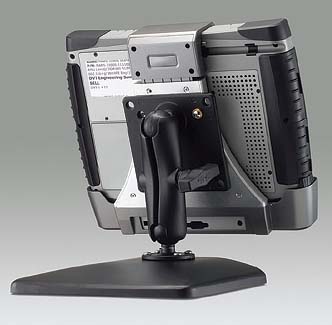 Industrial tablet computers like the MARS-3100S are primarily designed to be carried around and used in the field. However, thanks to their small size and lack of a bulky keyboard, many will be used in vehicles. And since they are also full-function computers they will see duty in offices and even homes. This means they'll require a variety of mounting and docking solutions. In a vehicle, the emphasis will be on secure, vibration-free mounting, perhaps with a quick-release. In an office environment the machine must be docked so that it comfortably works with a full-size keyboard and a mouse.
Industrial tablet computers like the MARS-3100S are primarily designed to be carried around and used in the field. However, thanks to their small size and lack of a bulky keyboard, many will be used in vehicles. And since they are also full-function computers they will see duty in offices and even homes. This means they'll require a variety of mounting and docking solutions. In a vehicle, the emphasis will be on secure, vibration-free mounting, perhaps with a quick-release. In an office environment the machine must be docked so that it comfortably works with a full-size keyboard and a mouse.
The image to the right shows the MARS-3100S secured in a dock. All side-mounted ports remain easily accessible. The dock also adds additional interface connectivity via the docking connector. Ports on the dock face backwards so as to keep cable clutter at a minimum.
Mounting arms use National Products' patented RAM-MOUNT solutions. The unique rubber ball and connector arm system makes for unparalleled flexibility and near total absence of vibration. To change the viewing angle, you simply loosen the large, grippy control knob, get the unit into the proper position, and tighten it. Mounting plates are all industry standard.
Bottom line
The Advantech MARS-3100S is an economical ruggedized industrial tablet computer from an experienced Taiwanese embedded and industrial systems company with a worldwide presence. It's small and handy, about the size of an 8-1/2 x 11 sheet of paper and it weighs just five pounds. The 3100S is internally configured as an embedded device running Windows XP Embedded on a 4GB solid state disk. 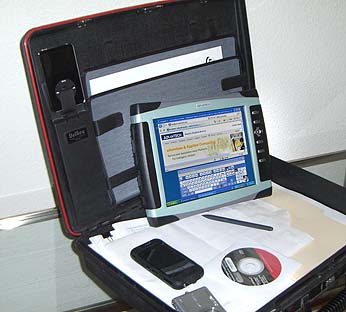 This means it can provide snappy performance from a highly energy-efficient AMD LX800 processor that has a Thermal Design Power of only 3.6 watts at full speed. This means battery life in excess of four hours. The unit does not need a fan, runs silently, and barely warms up. The aluminum-alloy body is very solid and there is extra protection in the form of high-impact plastic and rubber inserts and bumpers. The device is sealed to IP54 specifications and can take a lot of abuse. This means it can provide snappy performance from a highly energy-efficient AMD LX800 processor that has a Thermal Design Power of only 3.6 watts at full speed. This means battery life in excess of four hours. The unit does not need a fan, runs silently, and barely warms up. The aluminum-alloy body is very solid and there is extra protection in the form of high-impact plastic and rubber inserts and bumpers. The device is sealed to IP54 specifications and can take a lot of abuse.
In a class of computers where 8.4-inch screens still predominate, the MARS-3100S has a larger 10.4-inch display, and this can be a significant advantage. The resistive touch screen is very responsive thanks to a USB interface, and it is also highly configurable for optimal use with both a stylus or fingers.
The MARS-3100S offers good onboard connectivity for a rugged unit with such a high degree of dust and water sealing. You get a USB port (but not two), LAN, serial, video, audio in/out, and a docking connector. A SIM slot for available GSM/GPRS/EDGE communication is optional.
In the storage department, we'd like to see larger SSD options and also more than 512MB of RAM. A sunlight readable screen option would also be appreciated, and the protective rubber plugs should be attached to the unit so they can't get lost.
The MARS-3100S is an interesting machine that combines low cost with a clean industrial design, ruggedness, a large screen, and, thanks to the embedded OS and the solid state disk, surprisingly quick performance from its energy-efficient processor. It can be configured for a large variety of applications in manufacturing, warehousing, any type of field service, government and law enforcement applications, and more.
-- Conrad H. Blickenstorfer
Advantech MARS-3100S Specs:
| Type |
Semi-rugged pen tablet
|
| Processor |
500MHz AMD LX800 with 128KB L2 Cache (3.6 watts TDP max)
|
| Display Chipset |
AMD CS5536 |
| OS |
Windows XP Embedded
|
| Memory |
512MB DDR 400MHz via one memory slot |
| Display |
10.4" SVGA (800 x 600) TFT
|
| Digitizer |
Resistive touch screen |
| Keyboard |
Optional external USB |
| Storage |
4GB Compact Flash; Removable shock-mounted 2.5-inch hard disk option
|
| Expansion slots |
1 CF Card (may be used)
|
| Housing |
Magnesium-alloy housing |
| Size |
11.8 x 8.85 x 1.43 |
| Weight |
4.6 pounds
|
| Operating temperature |
32 to 122 degrees Fahrenheit |
| Ingress protection |
IP54 equivalent |
| Drop/shock/other |
3-foot drop, MIL-STD tested (vibration, safety, humidity, thermal shock, water/dust, mechanical shock, altitude) |
| Power |
Warm-swappable 11.1V/3,600mAh Li-Ion (observed: 4.5 hours"); hot-swappable battery system option |
| Interface |
1 USB 2.0, RJ45 LAN, 9-pin RS-232, video, audio in/out |
| Wireless options |
802.11a/b/g Mini-PCI; optional: Bluetooth V2.0/EDR; GSM/GPRS/EDGE
|
| Price |
depends on configuration |
| Contact |
Advantech www.advantech.com.tw |
(copyright 2008 RuggedPCReview.com)
Advantech Corporation
38 Tesla, Suite 100
Irvine, CA 92618
Toll Free: 1-800-866-6008
Ph: 949-789-7178
Fax: 949-789-7179
ECGInfo@advantech.com
www.advantech.com
Advantech Co. Ltd.
No.1, Alley 20, Lane 26, Rueiguang Road
Neihu District, Taipei Taiwan 114, R.O.C.
Tel: 886-2-2792-7818
Fax: 886-2-2794-7301
www.advantech.com
|



